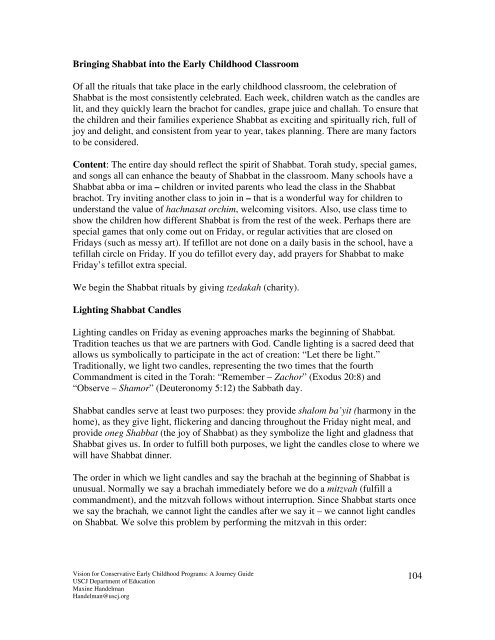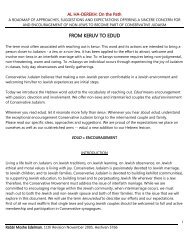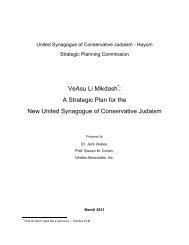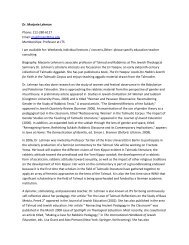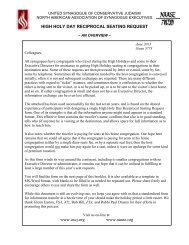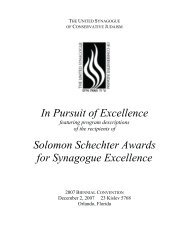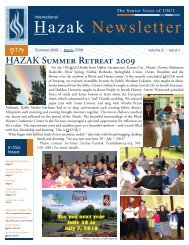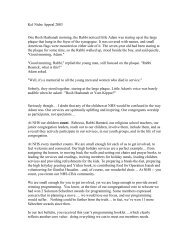Vision for Conservative Early Childhood Programs: A Journey Guide
Vision for Conservative Early Childhood Programs: A Journey Guide
Vision for Conservative Early Childhood Programs: A Journey Guide
Create successful ePaper yourself
Turn your PDF publications into a flip-book with our unique Google optimized e-Paper software.
Bringing Shabbat into the <strong>Early</strong> <strong>Childhood</strong> Classroom<br />
Of all the rituals that take place in the early childhood classroom, the celebration of<br />
Shabbat is the most consistently celebrated. Each week, children watch as the candles are<br />
lit, and they quickly learn the brachot <strong>for</strong> candles, grape juice and challah. To ensure that<br />
the children and their families experience Shabbat as exciting and spiritually rich, full of<br />
joy and delight, and consistent from year to year, takes planning. There are many factors<br />
to be considered.<br />
Content: The entire day should reflect the spirit of Shabbat. Torah study, special games,<br />
and songs all can enhance the beauty of Shabbat in the classroom. Many schools have a<br />
Shabbat abba or ima – children or invited parents who lead the class in the Shabbat<br />
brachot. Try inviting another class to join in – that is a wonderful way <strong>for</strong> children to<br />
understand the value of hachnasat orchim, welcoming visitors. Also, use class time to<br />
show the children how different Shabbat is from the rest of the week. Perhaps there are<br />
special games that only come out on Friday, or regular activities that are closed on<br />
Fridays (such as messy art). If tefillot are not done on a daily basis in the school, have a<br />
tefillah circle on Friday. If you do tefillot every day, add prayers <strong>for</strong> Shabbat to make<br />
Friday’s tefillot extra special.<br />
We begin the Shabbat rituals by giving tzedakah (charity).<br />
Lighting Shabbat Candles<br />
Lighting candles on Friday as evening approaches marks the beginning of Shabbat.<br />
Tradition teaches us that we are partners with God. Candle lighting is a sacred deed that<br />
allows us symbolically to participate in the act of creation: “Let there be light.”<br />
Traditionally, we light two candles, representing the two times that the fourth<br />
Commandment is cited in the Torah: “Remember – Zachor” (Exodus 20:8) and<br />
“Observe – Shamor” (Deuteronomy 5:12) the Sabbath day.<br />
Shabbat candles serve at least two purposes: they provide shalom ba’yit (harmony in the<br />
home), as they give light, flickering and dancing throughout the Friday night meal, and<br />
provide oneg Shabbat (the joy of Shabbat) as they symbolize the light and gladness that<br />
Shabbat gives us. In order to fulfill both purposes, we light the candles close to where we<br />
will have Shabbat dinner.<br />
The order in which we light candles and say the brachah at the beginning of Shabbat is<br />
unusual. Normally we say a brachah immediately be<strong>for</strong>e we do a mitzvah (fulfill a<br />
commandment), and the mitzvah follows without interruption. Since Shabbat starts once<br />
we say the brachah, we cannot light the candles after we say it – we cannot light candles<br />
on Shabbat. We solve this problem by per<strong>for</strong>ming the mitzvah in this order:<br />
<strong>Vision</strong> <strong>for</strong> <strong>Conservative</strong> <strong>Early</strong> <strong>Childhood</strong> <strong>Programs</strong>: A <strong>Journey</strong> <strong>Guide</strong><br />
USCJ Department of Education<br />
Maxine Handelman<br />
Handelman@uscj.org<br />
104


